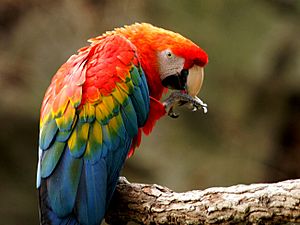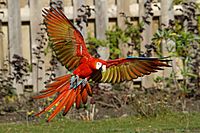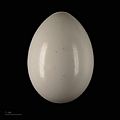Scarlet macaw facts for kids
Quick facts for kids Scarlet macaw |
|
|---|---|
 |
|
| Scarlet macaw (Ara macao) | |
| Scientific classification | |
| Kingdom: | |
| Class: |
Aves
|
| Order: | |
| Family: | |
| Subfamily: | |
| Binomial name | |
| Ara macao Linnaeus, 1758
|
|
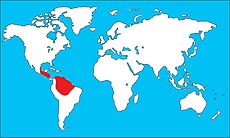 |
|
| Range shown by the red area | |
The scarlet macaw (Ara macao) is a large, colorful parrot from Central and South America. It's famous for its bright red, yellow, and blue feathers. These amazing birds are part of a group called macaws and live in warm, wet forests.
Contents
What Does a Scarlet Macaw Look Like?
Scarlet macaws are quite large, growing to about 81 centimeters (32 inches) long. Their long, pointed tail can be more than half of their total length! They weigh around 1 kilogram (2.2 pounds).
Their feathers are mostly bright red, like the color of a scarlet cape. But they also have light blue feathers on their lower back and tail. The upper part of their wings has bright yellow feathers, and the tips of their wing and tail feathers are dark blue. The underside of their wings and tail are dark red. Sometimes, you might even see a bit of green on their wings.
Around their eyes and extending to their bill, scarlet macaws have bare white skin. This skin has tiny white feathers on it. The top part of their beak is usually a pale, light color, while the bottom part is black. Young macaws have dark eyes, but as they grow up, their eyes turn light yellow.
It's easy to mix up a scarlet macaw with the slightly bigger green-winged macaw. However, green-winged macaws have more clear red lines on their face and no yellow feathers on their wings.
Scarlet macaws are known for being very loud! They make high-pitched and sometimes low, rumbling squawks, squeaks, and screams. These loud calls can travel for many miles, helping them communicate with other macaws in their group.
In places like zoos, scarlet macaws can live for a very long time, sometimes up to 75 or even 90 years! In the wild, they typically live for about 40 to 50 years.
How Do Scarlet Macaws Behave?
Scarlet macaws are usually seen alone or in pairs. You won't often see them flying in large groups. However, many birds might gather together at special places called clay licks. These birds use different sounds to talk to each other. Macaws that are kept as pets can even learn to copy human speech!
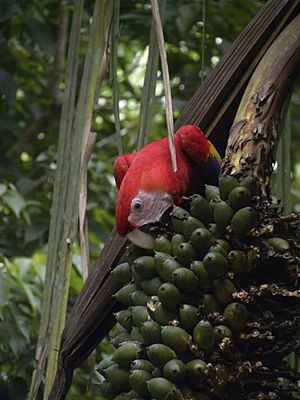
What Do Scarlet Macaws Eat?
Scarlet macaws mostly eat fruits, nuts, and seeds. They are strong enough to crack open large, hard seeds. They also enjoy eating insects and their larvae (young bugs). Bugs, snails, and leaves are an important part of their diet. Snails and insects give macaws a lot of protein, which is especially important when they are raising their young. They also add flowers and nectar to their meals.
Scarlet Macaw Reproduction and Life Cycle
During the time they are breeding, scarlet macaws can become quite protective. These birds choose one partner and stay with them for their entire lives. The female macaw lays two or three white eggs inside a hollow tree.
The mother bird sits on the eggs for about five weeks to keep them warm. This is called incubation. After the chicks hatch, they stay in the nest for about 90 days before they are ready to fly. They stay with their parents for about a year after leaving the nest. Young scarlet macaws are ready to have their own families when they are about five years old.
Where Do Scarlet Macaws Live?
Scarlet macaws live in warm, wet rain forests, open woodlands, along river edges, and in grassy areas called savannas. These areas are usually in lowland subtropical regions.
Their natural home stretches across a huge area, about 6,700,000 square kilometers (2,586,884 square miles). You can find them in the Amazon basin, reaching into Peru and Bolivia.
In Central America, their range goes from eastern and southern Mexico and Panama through Guatemala and Belize. They also live on the island of Coiba and sometimes on the mainland of Panama. In Costa Rica, they are found in specific areas on the Pacific Coast, like the Nicoya Peninsula, Carara National Park, and Peninsula de Osa.
Protecting Scarlet Macaws
The scarlet macaw is currently listed as a species of "least concern" by the IUCN (International Union for Conservation of Nature). This means they are not in immediate danger of disappearing. It's thought that there are between 50,000 and 499,999 scarlet macaws living in the wild.
However, it is against the law to buy or sell scarlet macaws (or parts of them) across countries. This rule is set by CITES (Convention on International Trade in Endangered Species) because too many macaws were being caught and sold as pets. This illegal hunting is called poaching.
The northern group of scarlet macaws, called A. m. cyanopterus, is listed as endangered by the USFWS (U.S. Fish and Wildlife Service). The USFWS believes that only about 2,000 to 3,000 birds of this northern group are left in the wild.
Images for kids
-
A scarlet macaw with a blue-and-yellow macaw below it.
-
A pair of scarlet macaws at ZooTampa at Lowry Park in Tampa, Florida.
See also
 In Spanish: Guacamayo escarlata para niños
In Spanish: Guacamayo escarlata para niños


